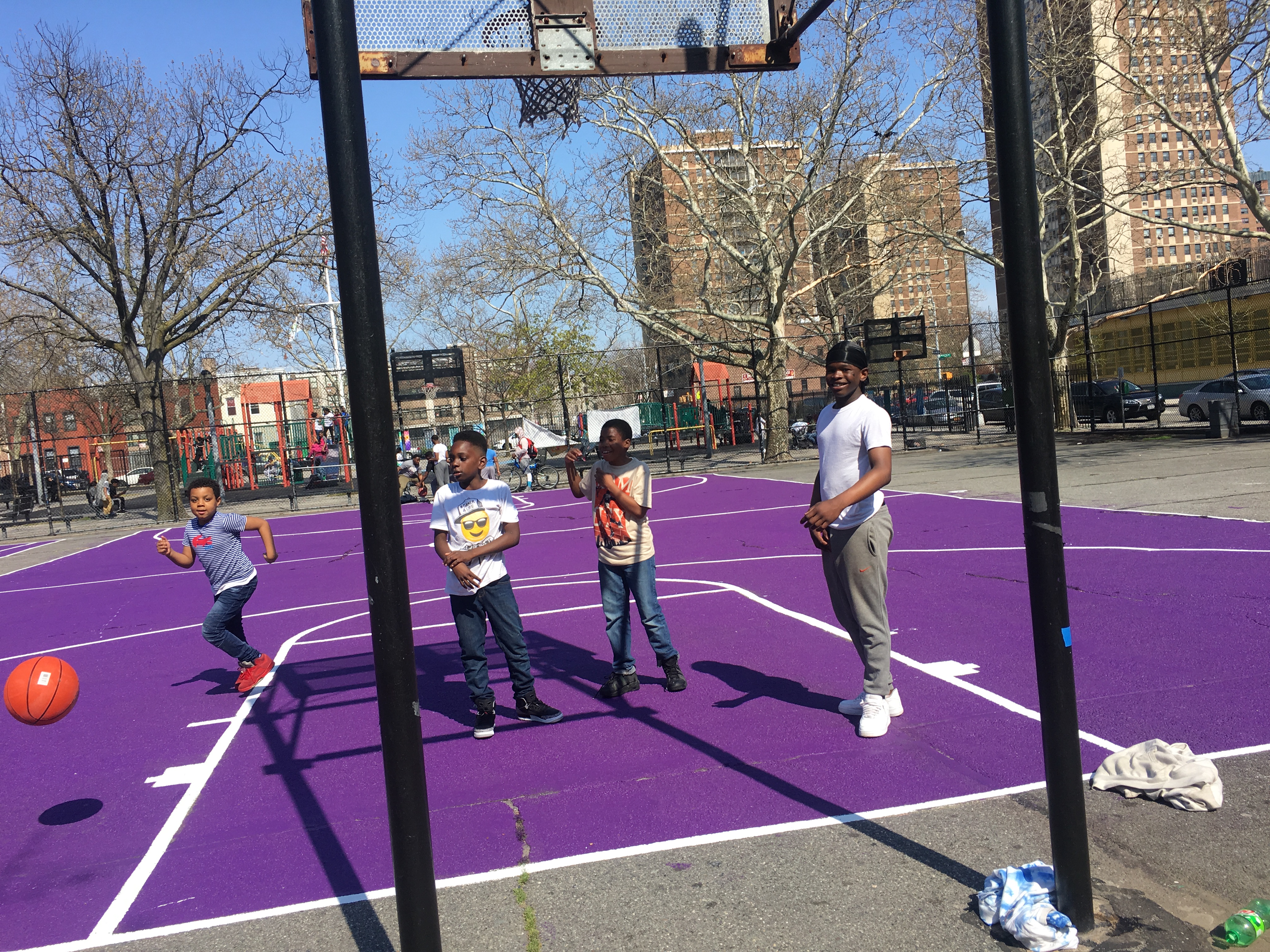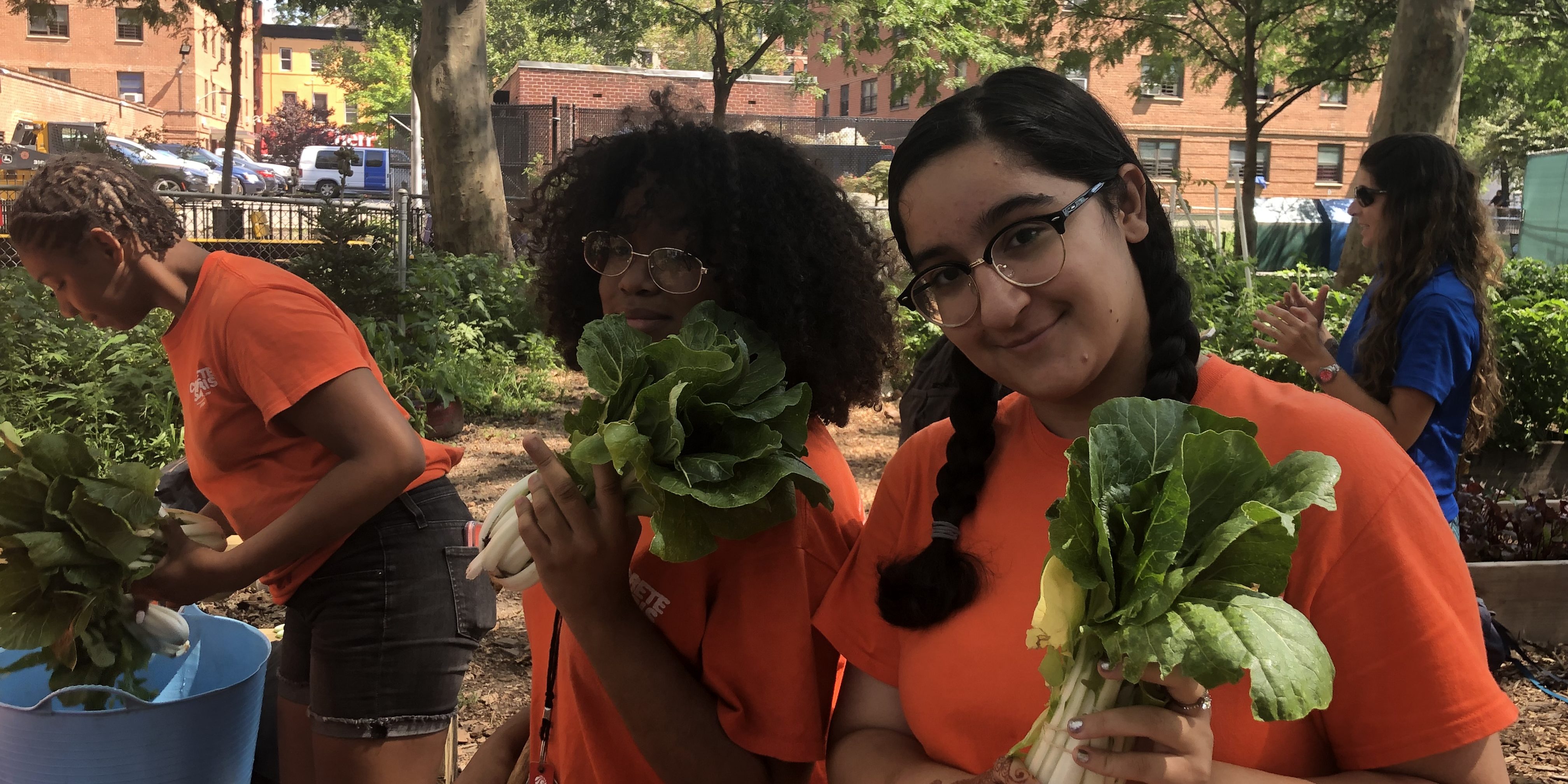Progress Areas
Enhancing Impact

Goal
Leverage our resources to increase impact
Progress
- Leveraged nearly $82 million from public and private sources, including direct co-funding and money raised.
What this means
Leveraging is a strategy across all program areas. Since 2009, approximately $606 million has been leveraged.
Leveraging has allowed us to support efforts in specific regions of the State, to help sustain those efforts, and to expand them across the State.
Enhancing Impact

Goal
Deploy activist model to achieve broad policy impact
Progress
- Protected and promoted Supplemental Nutrition Assistance Program (SNAP) benefits to New Yorkers. This includes opposing federal proposals to restrict eligibility requirements and limit benefits, as well as recommending how incentives to buy fresh produce could be better incorporated into the SNAP program.
- Identified effective suicide prevention strategies for veterans used in other states and convened diverse stakeholders to jumpstart replication in New York.
- Responded to a range of requests for public comments, including on new price transparency requirements and for making health care information more easily available to patients.
What this means
We are continuing efforts to be not just a grantmaker, but also a changemaker.
Using our reputational and human capital enhances our impact beyond grantmaking.
Participating in public comment processes is a way to inform and influence policy. We plan to be active contributors of such policy documents.
Building Healthy Communities

Goal
Promote community cohesion, organizational capacity, and sustainability
Progress
- Facilitated peer-to-peer learning between communities. Neighborhood leaders and local organizations shared strategies and lessons learned on issues ranging from neighborhood safety to cultivating resident participation.
- Replicated successful strategies across neighborhoods. Syracuse’s Near Westside and Niagara Falls installed new murals on walking trails depicting messages about healthy eating. Niagara Falls is also replicating the Near Westside’s Kitchen Table Talks model.
What this means
Creating networks of engaged local organizations has strengthened each community’s ability to identify problems and develop solutions. Eliciting broad community buy-in provides a framework for common goal-setting and action planning.
Collaboration has enhanced impact and fostered the spread of successful strategies across regions.
Resident-led initiatives, such as the Kitchen Table Talks, have cultivated local leadership that will enhance sustainability over the long term.
Building Healthy Communities

Goal
Improve access to safe places where residents can be more physically active
Progress
- Activated approximately 15 parks and public spaces in 2019, including an inclusive play space for children of all abilities.
- Grantees in Lower East Side will activate alternative spaces in anticipation of local park closures for construction. East Harlem audited the Community Walking Trail and trained residents to use the 311 system app as a strategy for improving the built environment.
- Launched the Try Five Challenge to promote physical activity, led by the Clinton County Health Department.
What this means
Investments in park and public space improvements and efforts to activate safe spaces have increased access.
Improvements are not limited to capital improvements, but include activities to address barriers to walkability, create physical accessibility, and implement formal programs, classes, and leagues that encourage participation.
Challenges still exist. For example, real and perceived public safety concerns persist in some neighborhoods. Many organized programs are limited to warmer weather.
Building Healthy Communities

Goal
Improve access to and demand for nutritious foods
Progress
- Supported new access points to healthier food; including an African Heritage food co-op in Niagara Falls and a food market in downtown Syracuse.
- Expanded access to a wider selection of healthier food options at existing access points, such as at locally-owned convenience stores, small grocery stores, and local eateries in Clinton County.
- Identified incentive programs across the State that increase the consumption of fresh produce by low-income New Yorkers. Recommended ways to make it easier for residents and vendors/food producers to participate in these programs.
- Niagara Falls completed its Local Food Action Plan, which was adopted by the City Council.
What this means
NYHealth has supported substantial increases in the number of healthy food outlets in Building Healthy Communities neighborhoods. Although there were fewer new access points launched in 2019 than in prior years, existing access points focused on growth and sustainability.
Low-income communities face persistent challenges to improving their food environments. Strategies are dependent upon additional funding, incentives, and ongoing management support.
Policy approaches, including publicly and privately funded nutrition incentives, have a huge impact on creating access. Moving forward, NYHealth will work with neighborhoods to link their local solutions to broader policy change.
Empowering Health Care Consumers

Goal
Ensure greater transparency of and access to price, quality, and patient experience information
Progress
- Created new transparency tools and resources to arm New Yorkers with health care information:
- Launched a consumer-driven campaign in partnership with local media to educate the public about price variations in shoppable health care services in New York City.
- Invested in the development of a consumer-friendly interface for the all-payer database that New Yorkers will be able to use as a centralized go-to source for information on provider networks, prices, and quality.
- Northeast Business Group on Health (NEBGH) partnered with Yelp to begin publishing maternity care measures for more than 50 hospitals across New York City and Long Island.
- Supported one of New York State’s largest self-insured employers to develop a High Value Maternity Network.
- Supported implementation of OpenNotes at federally qualified health centers to make doctors’ clinic notes accessible and actionable for patients.
- Released a statewide quality transparency survey that gathered New Yorkers’ perspectives on the types of health care quality measures that matter to them.
What this means
In 2019, NYHealth built upon previous years’ successes in the development of transparency tools by focusing on enhancing the use of the tools among consumers.
Consumer story sharing is a powerful tool to educate others on how to navigate the health care system and to ignite policy change.
Large employers, as purchasers of care, can be leaders in shifting the health care system toward more patient-centered and value-based approaches.
NYHealth previously supported the implementation of OpenNotes in hospitals across the State. Although there have been challenges in uptake because of provider resistance, limitations in some electronic health record systems, and concerns about accessing pediatric and mental health notes, the number of patients who have access to their notes continues to grow.
There is room for improvement when it comes to how New Yorkers access and use health care quality information.
Empowering Health Care Consumers

Goal
Ensure that patients are partners in the clinical care delivery experience
Progress
- Piloting a Patient and Family Advisory Council (PFAC) model that employs a technology platform to broaden patient voices in practice transformation.
- Supported a cohort of hospitals across New York State to achieve Planetree designation, an intensive training and reorientation process that positions a hospital to be a leader in patient and family engagement and person-centered care practices.
- Piloted a training program at 40 New York State hospitals to improve family presence and general visitation policies, including 24-hour presence programs, hospital website communications, and best practices for caregiver resources. An evaluation found that visitation policies improved, but there is more work to be done.
What this means
Meaningful patient-engagement policies minimize patient burdens and create more accountability. Many physicians have not been formally trained to build working relationships with patients and their family caregivers.
Isolating hospital patients from their loved ones at their most vulnerable time can place them at risk for medical error, emotional harm, inconsistencies in care, and a greater likelihood of readmission. 24/7 open visitation is one way to strengthen family and caregiver involvement in a patient’s health care experience.
Empowering Health Care Consumers

Goal
Ensure that patients are partners in informing care delivery and health policies
Progress
- Worked to add more consumer representatives to the New York State Public Health and Health Planning Council.
- Advised New York City Council on creating an Office of the Patient Advocate.
- Trained New Yorkers, especially in marginalized communities, to advocate for policy change on critical health issues and to communicate their stories, needs, and policy priorities.
- Supported campaign to increase patients’ capacity to drive health care reform, beginning with efforts to simplify medical billing.
What this means
Consumers need a lasting and meaningful seat at the table. In 2019, NYHealth expanded our work to help New Yorkers drive and inform decisions that affect health care policy, quality, access, and costs in New York State.
NYHealth is exploring innovative ways to better engage, train, and develop under-represented patient champions.
Improving Veterans’ Health

Goal
Increase visibility of veterans’ health issues
Progress
- Organized numerous public events related to veterans’ issues, including:
- “Conversation With” events with the former Secretary of Veterans Affairs, New York State’s newest director of Veterans’ Services, and the new leader of an emerging post-9/11 veteran service organization, as well as on issues facing veterans in upstate New York.
- Spoke at 17 events sponsored by others, including:
- Grantmakers in Health
- NYS Division of Veterans’ Services
- NYS Division of Human Rights
- The Council on Foundations
- America’s Warrior Partnership
- New York Funders Alliance
- Released a blueprint to increase effectiveness of the State’s division of veterans’ services.
- Convened a multi-stakeholder group to expand Veterans Treatment Courts (VTCs) across the State and create universal access for justice-involved veterans. Educated key policymakers on the benefits of VTCs. Garnered significant media attention and organized a coalition of supporters. By the end of 2019, both chambers of New York State’s Legislature introduced bills to create universal VTC access.
What this means
In addition to grantmaking, NYHealth uses leadership and leverage to advance our work on veterans’ health.
In the coming year, the Foundation will continue leveraging all of our assets to help create universal VTC access, and will remain committed to serving as a convener that brings together valued stakeholders to address pressing veterans’ health issues, such as veteran suicide.
Improving Veterans’ Health

Goal
Increase access to comprehensive community-based services for veterans and their families
Progress
- Invested in veteran competency trainings for clinicians in New York City.
- Piloted a model for improving access and the quality of care veterans receive at a community health center. The work will test a model for replication by other community health centers.
What this means
These grants and staff activities are aimed at streamlining access to non-VA providers while improving the quality of care veterans receive in community-based settings across the State.
NYHealth will remain focused on investing in organizations that can address the growing needs of veterans, while also facilitating collaborations across various public and private organizations to identify and address emerging issues affecting New York’s veteran community.
Special Projects Fund

Goal
Supporting new endeavors and organizations
Progress
265 letters of inquiry received:
- Nearly half of Special Projects Fund grants awarded in 2019 were to new grantees not previously funded by NYHealth.
What this means
The Special Projects Fund continues to keep the door open to work with a wider variety of grantees. This expands our audience and maintains a culture of openness to new players and ideas.
Special Projects Fund

Goal
Being responsive to emerging trends
Progress
- In 2019, Special Projects Fund grants addressed a wide range of topics, including access to mental health services by students of color to reduce campus suicide rates, health assessments for refugee/asylum seekers, and improving HPV vaccination rates among adolescents.
- Replicated programs proven to be effective in addressing the opioid crisis in other states, including The Law Enforcement Assisted Diversion (LEAD) program, an evidence-based, harm-reduction oriented program designed to reduce low-level arrests and recidivism while promoting better health outcomes.
- Created a social media surveillance system designed to help New York’s public health officials, health care systems, and providers counter vaccine and other health disinformation initiatives occurring throughout the State.
What this means
The program balances our strategic grantmaking directed at specific priorities with grantmaking that is responsive to time-sensitive and emerging issues.
We are able to leverage lessons learned and successes from prior projects, such as the LEAD pilot in Albany. The model has now been implemented in seven communities, with plans for six more throughout New York State.
The Special Projects Fund allows the Foundation to contribute on issues that require innovative thinking to address some of the most challenging issues in the health care sector.
Policy and Research

Goal
Conceive and generate original research informing health policy issues in New York State
Progress
- Produced analyses on pressing issues, including:
- The potential impact of the new law to eliminate religious exemptions for school vaccination requirements in New York State.
- Cost trends in New York’s commercial insurance market, highlighting the role of prices versus utilization in the growing costs.
- Vaping in New York State, as a national outbreak of illnesses linked with vaping products continued to rise and health officials grew increasingly concerned.
- The impact of New York’s surprise bill law, as well as considerations for further enhancements that can be made to continue New York’s leadership on an issue that is increasingly receiving attention nationally.
- Published peer-reviewed journal publication on the variation in health care spending across New York State, discussing potential implications for provider payment and delivery system reform.
- Published blog posts on the state of hospital price transparency efforts and alternative methods for setting public health benchmarks for counties across the country.
What this means
These analyses complement our external grantmaking activities and support the Foundation’s agenda to inform health policy issues facing New Yorkers.
The range of topics allows us to enhance the work of our grant-making as well as to provide input on issues outside of our current program priority areas.
Our work has helped expand the Foundation’s reach to a wide network of stakeholders. For example, our work analyzing severe maternal morbidity has helped inform the development of insurance benefit designs for a large employer in New York.
Communicating Effectively

Goal
Increase the visibility, credibility, and influence of the Foundation and our grantees
Progress
Publishing
- Published 20 reports and 16 commentaries, in addition to 32 grant outcome reports.
- Published 8 op-eds and letters to the editor.
Traditional Media
- Received 165 media hits.
E-mail/Social Media
- Maintained more than 13,000 contacts on our e-mail lists.
- Averaged 25% open rate for e-mail blasts (industry standard is 19%).
- Nearly 6,500 Twitter followers.
Convening
- Held 33 convenings; highlights include:
- Large external conferences on the Foundation’s program areas of Building Healthy Communities and Veterans’ Health.
- More than 3,700 views of NYHealth events via Facebook Live.
Website
- Continued to refine the website to support publications that are less text-heavy, more digestible, and more shareable and interactive.
- Continued to experiment with dynamic infographics on website and social media to increase engagement.
What this means
A robust and proactive communications program is a fundamental part of the Foundation’s operating model.
Communications shape the visibility, reputation, influence, and impact of the Foundation and the work supported through our grantmaking.
Communications metrics reflect growing profile within New York State and nationally.
We continue to use technology—including Facebook Live—to engage our audience virtually.
Investing & Operating Effectively

Goal
Strong endowment/ investment performance
Progress
- As of December 31, 2019, the 3-year compound annual return on endowment investments was 9.6%, net of fees.
- Investment performance relative to peers for the 3-year period ending September 30, 2019 (latest comparison available) ranked in the 81st percentile.1
- Maintained return of 6.7% since inception (July 2006).
- When compared with the benchmark of 5% plus CPI (Consumer Price Index) since inception, NYHealth was 0.1% below the benchmark.
1 Peer data is based on a survey conducted by Cambridge Associates; “Peers” are defined as foundations with less than $500 million in assets. There are currently 60 foundations contributing such data.
What this means
The value of our endowment in 2006 was $265 million. Since then, investment return has been in top quintile of peer group, allowing the Foundation to spend $200.4 million on grants and operations.
The Foundation is monitoring signs of continued volatility in investment markets.
Investing & Operating Effectively

Goal
Strong internal management and customer service
Progress
- For 2018, NYHealth was certified with another clean audit.
- The average rating by grantees of NYHealth staff members responsiveness was 6.1 (out of a 7-point scale), placing NYHealth highly relative to peer foundations.2
- In 2019, all grantees received their initial payment within an average of 11 days of receiving an award notice.
2 Based on the 2019 Center for Effective Philanthropy Grantee Perception Survey.
What this means
Receiving a clean audit each year reflects our commitment to operational efficiency and transparency.
Our goal is to continue to improve upon our customer service to grantees.
Providing timely funding is especially important for smaller organizations working on time-sensitive issues.


